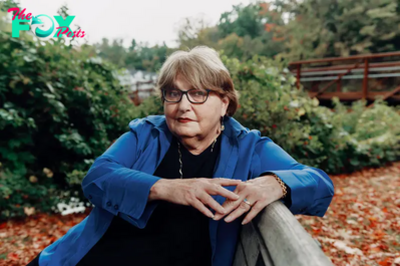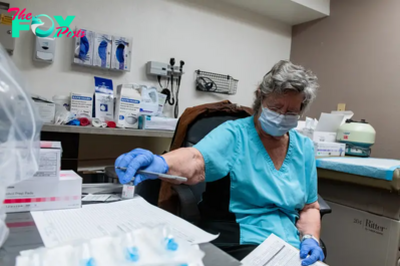Health
A Western Slope program is helping older Coloradans maintain independence
By Nancy Lofholm, The Colorado Trust
Sandra Dee Powell is in a wheelchair. She suffers from a blood clotting problem in her legs. Cerebral palsy has twisted her right hand since birth. But the 74-year-old widow and retired day care provider can live alone in her home thanks to a government program that accommodates her needs.
A certified nursing assistant comes to Powell’s home each morning and evening to help her get in and out of bed. An assistant prepares an evening meal for her. A helper comes regularly to clean her home. A van takes her to all medical and dental appointments.
Four days a week, a van brings Powell to an 80,000-square-foot former office building, where she is dropped off under a large sign that reads “Center for Living Your Best.” There, Powell has lunch, receives health care and help with showers, and maintains an active social life with friends she has made over the past two years.
“I can say that I enjoy every day here,” Powell said as she eagerly tucked into a grilled cheese and tomato soup lunch at the center’s dining room.
The center houses the HopeWest PACE program, which delivers wide-ranging services for older adults. HopeWest PACE is a local fulfillment of a national Centers for Medicare & Medicaid Services program known as PACE, which stands for Program of All-Inclusive Care for the Elderly.
HopeWest PACE is one of 150 programs nationwide that carry out the PACE mandate to keep qualifying older adults like Powell living in their homes by providing them with a holistic bundle of health care and social and emotional support. It includes primary and specialty medical care, prescription medications, physical and occupational therapy, recreation, dietary counseling, and mental health counseling.
For Powell, that means an interactive team of caregivers keeps tabs on her overall needs, including any chores at home. The team assigns physical and occupational therapists to keep her as mobile as possible in a PACE-supplied electric wheelchair. Caregivers interact with Powell while she is socializing with friends at the PACE day center to ensure she stays as healthy as possible and feels safe in her home and fulfilled in her life.
“Socialization is important. The majority of our people live alone,” said Jamie Renfro, manager of the HopeWest PACE day center. “A lot of them hadn’t been very social for a while before they came here.”
Powell confirmed that was true in her case. The COVID-19 pandemic was particularly tough because she barely saw anyone else. That time is just a bad memory at this point, she said.
“Every day is good now,” Powell said while piecing together jigsaw puzzles and chatting with friends.
A national program that started small
The Grand Junction PACE program has given Medicaid-eligible seniors an alternative to nursing homes for nearly two and a half years. PACE has been operating nationally for more than a quarter of a century. It morphed from a local model of care that originated in 1971 in San Francisco when a nonprofit was formed to meet the needs of older immigrants in the Chinatown area. The program was replicated in other communities and, in 1997, was officially made a funded part of the Medicare and Medicaid systems.
Colorado now has five PACE programs. A sixth was recently approved to serve Denver County and portions of neighboring counties. The state can potentially add more as Colorado’s older adult population is projected to increase by 68% by 2030.
The PACE program uniquely appeals to older adults with an independent streak, like Powell, who want to remain at home in their later years rather than move into nursing or assisted living homes. Most Americans say they would like to age in place. More than half of Medicaid’s long-term-care spending now goes to older adults and people with physical disabilities who live in private homes or communities rather than in institutional settings.
Despite PACE’s lengthy History and the documented need, PACE is not a widely known government service. Some enrollees in the Grand Junction PACE program said they had no idea it existed or what it was until someone recommended it.
“It was a freak, one of those meant-to-be things,” said 89-year-old Mary Hill, who learned of PACE after a friend had a stroke and was enrolled by her daughter in the brand-new HopeWest PACE program. Hill researched the program, found she could qualify, and became one of the first participants.
Powell was an early enrollee after she and her daughter began shopping for a nursing home or assisted living center after Powell had struggled through pandemic-induced isolation. Powell’s primary care provider told them about the PACE option. Powell quickly decided it was perfect for her needs.
“I had lived in my house for 26 or 27 years,” Powell said. “I didn’t want to leave. I might be in this wheelchair, but I’m still very independent.”
Powell and Hill had no trouble meeting the four criteria to qualify for the program. Applicants have to pass an assessment for safety in their homes; they must be at least 55 years old; they must live in the zip codes of the service provider; and they have to be “functionally eligible,” meaning they must have limitations with the activities of daily living that qualifies them for nursing home care.
-

 Health13h ago
Health13h agoThe Surprising Benefits of Talking Out Loud to Yourself
-

 Health15h ago
Health15h agoDoctor’s bills often come with sticker shock for patients − but health insurance could be reinvented to provide costs upfront
-

 Health1d ago
Health1d agoWhat an HPV Diagnosis Really Means
-

 Health1d ago
Health1d agoThere’s an E. Coli Outbreak in Organic Carrots
-

 Health2d ago
Health2d agoCOVID-19’s Surprising Effect on Cancer
-

 Health3d ago
Health3d agoWhat to Know About How Lupus Affects Weight
-

 Health6d ago
Health6d agoPeople Aren’t Sure About Having Kids. She Helps Them Decide
-

 Health6d ago
Health6d agoFYI: People Don’t Like When You Abbreviate Texts



























